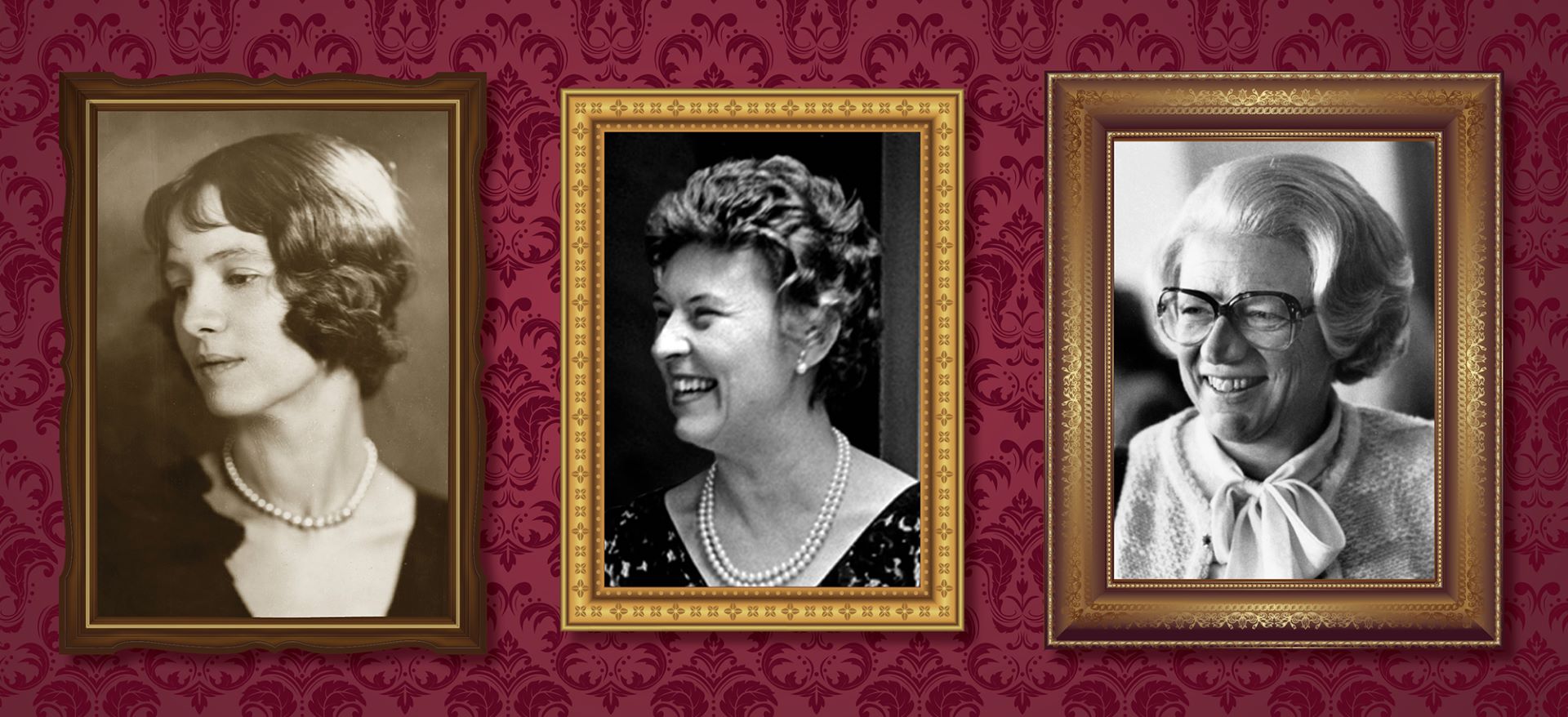
Left to right: Maude Hutchins, wife of President Robert Hutchins (1929–51); Muriel Beadle, wife of President George Beadle (1961–68); Hanna Holborn Gray, President (1978–93), now Harry Pratt Judson Distinguished Service Professor Emeritus. (Photo illustration by Michael Vendioloa; left to right: Copyright 2019, The Chicago Maroon. All rights reserved. Reprinted with permission.; Photography by Stanley Karter, EX’66, UChicago Photographic Archive, apf1-06531, University of Chicago Library; UChicago Photographic Archive, apf3-02421, University of Chicago Library)
An evening of book club gossip about Maude Hutchins, Muriel Beadle, and Hanna Holborn Gray.
In the cramped quarters of the Hyde Park Historical Society, a small group gears up for an evening of historical side-eye. The topic of the evening’s book club discussion is ostensibly “Remarkable Women of the University of Chicago: Hanna Holborn Gray, Muriel Beadle, Maude Hutchins,” but it soon becomes apparent that no University figure will be spared.
A gentleman named Sam, seemingly a regular book club attendee, is mid-diatribe. He declares Lawrence Kimpton, the University’s sixth president, “a certified moron,” then shifts his attention to a slim paperback volume published by the University of Chicago Press, which, he notes with disdain, lacks an index. “How does anyone allow something like this?” he fumes.
“Sam, you’re on a roll tonight,” says Michal Safar, president of the Hyde Park Historical Society. She leads the monthly book club, selecting the topics and lengthy reading lists. The attendees are mostly in their 60s and 70s and have varying connections to the University: there are alumni, retired staff members, and Hyde Parkers with an interest in neighborhood history.
Safar begins with Maude Hutchins, who, one suspects, would have relished this evening’s shade throwing. Maude, a sculptor and portrait artist, had a flair for the dramatic and enjoyed shocking people, Safar explains. She once used a stylized nude drawing she’d made of her 11-year-old daughter as the family’s Christmas card.
Safar begins tentatively: “This is …”
“Weird,” says one attendee.
“Salacious,” says another.
“… interesting,” Safar concludes.
As her troubled marriage to University president Robert Maynard Hutchins came to an end (they divorced in 1948), Maude began writing racy dime novels. Some people think the novels were largely an attempt to embarrass her ex-husband, Safar says. She passes around Maude’s 1950 novel, A Diary of Love (New Directions), which features a risqué cover and the tagline “The sexual awakening of a teen-age girl!”
One of the attendees has read Maude’s novel Georgiana (New Directions, 1948) but didn’t think much of it. Safar agrees: “I found her novels unreadable. I found her life fascinating.”
The group’s mood lightens as the discussion shifts to Muriel Beadle, a onetime journalist who married the Nebraska-born geneticist George W. Beadle in 1953. Several have read and enjoyed Muriel’s Where Has All the Ivy Gone: A Memoir of University Life (Doubleday, 1972), about the couple’s experiences during George’s presidency.
If Maude Hutchins hated the wining-and-dining part of being a president’s wife, Muriel Beadle seemed to relish it—she was “the good wife,” Safar observes. One attendee remembers the Beadles as unusually down-to-earth. It wasn’t unusual to see George puttering in a campus plot, she says, where he grew unusual varietals of corn.
The Beadles were also serious cat people, Safar notes. Among Muriel’s publications is The Cat: History, Biology, and Behavior (Simon and Schuster, 1977). The couple kept 17 cats at their home in Pasadena, California, but gave all but two away before they moved to Chicago. (One later got onto the sharply pitched roof of the president’s house; George, belayed by a terrified campus cop, gamely retrieved the wayward feline.)
Next up: Hanna Holborn Gray, the University’s first and so far only female president. Safar holds up Gray’s memoir, An Academic Life (Princeton University Press, 2018), and declares she liked it. A man who has been quiet for most of the evening responds with a very UChicago question: “You liked it because of what? What criteria did you use?”
Several attendees were struck by Gray’s recounting of her family’s experience as German-Jewish émigrés in the 1930s. Some found the book too circumspect and wished for more Muriel Beadle-esque frankness. Gray is used to that: “Much interest was shown in my domestic life and arrangements,” she notes in the book. At the grocery store, shoppers would “look with undisguised curiosity into my shopping cart.” One day she discovered “a distinguished professor of law” peeking into her garage window, “presumably to find out what kind of car we drove.” Well, what kind of car was it? Gray isn’t telling.
An Academic Life is upfront about some aspects of her life as a woman in academia. Her husband, Charles Gray, a legal history scholar, sometimes skipped events, which did not “seem to arouse concerns, as it would likely have done had he been a female spouse,” Gray notes without bitterness. “Not having a wife, I did the planning and oversight of dinners and receptions, selected the menus, and arranged the seating. I like doing those things.” No grist here for the book group, who by the end of the meeting are back to gossiping about University figures not on the syllabus.
